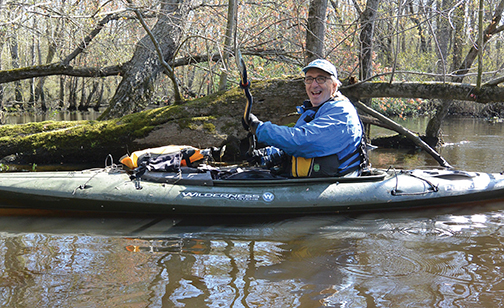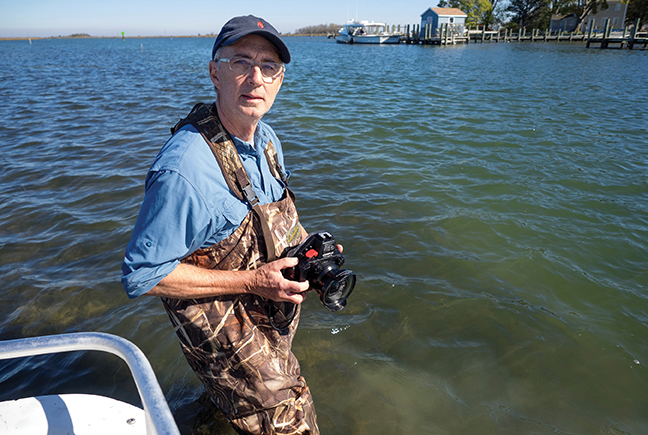After a storied career, photojournalist David W. Harp has set his focus squarely on the Chesapeake Bay
Documentary photographer David W. Harp’s inspiration comes from exploring literal and figurative edges where culture and nature connect, creating the essence of what defines the Chesapeake Bay. His newest exhibition, Where Land and Water Meet: The Chesapeake Bay Photography of David W. Harp, recently debuted at the Chesapeake Bay Maritime Museum
and will be on display at Salisbury University’s Guerrieri Academic Commons from January 31 to June 5, 2022.
From legendary skipjacks and intimate portraits of captains and crew to images capturing marsh guts, waterfowl and watermen at work, to more contemporary digital images documenting changing landscapes and lifestyles, Harp’s body of work represents a career spent immersed in the natural world, perfecting the art of observation.
Nabb Research Center archivist Ian Post recently sat down with Harp as he reflected on his career and the many changes he has witnessed on the Chesapeake Bay.
How did you first become interested in photography? What inspired you to document the Chesapeake Bay in particular?
So, when I was 10 years old, you could get coupons when you bought butter. After you collected a certain number of coupons, you could redeem them for things. I redeemed coupons my mother gave me for a little plastic camera, and I used it for a good number of years, probably just as a kid going off to camp and stuff.
At the Baltimore Sun, in the ’80s, I met Tom Horton. I was the Sunday magazine photographer; he was environmental writer. We started doing these Bay stories together for the magazine, and that developed. Now, some 40 years later, we’re still collaborating on things, on books and now on films. I just fell in love with the Bay. I’ve always been an outdoor person and was a Boy Scout and went camping, so I’m an outdoor dog, and now I just really love getting out. It’s just been combining that love of being outside and nature and an interest in photography.
There are so many beautiful places on the Chesapeake. What’s your process for selecting a location?
I always enjoy just seeing something I haven’t seen before or a place I haven’t seen before. I love marshes; I love kayaking. I’m a big kayaker; I love working from a kayak. In terms of picking a place, I think I prefer sort of the lowland, upstream areas. You get to the main step of the Bay, and you could be anywhere. You’re out in just water. But you get up into the marshes, and you get up into the upper parts of the creeks, and that’s where there’s this incredible diversity of life, and that’s what I photograph. Just all the little flora and fauna, and people catching things and people just getting out. I love the different seasons. It’s just change; it’s never quite the same. You can go back to the same place a hundred times, and it’s never the same. I enjoy that.
You’ve described yourself as a journalist and not as an art photographer, but what is the distinction in your mind, and how does that shape the way that you work?
I never proposed to be an artist; I grew up as a journalist. It’s telling stories that I like to do.
I like to use the camera. Tom and I use this saying that the whole is greater than the sum of its parts. I think if you have good writing and good photography, then you can tell a really great story. You can show people and have them feel what it’s like to be there.

Many of the images that you’ve taken required you to venture out into remote areas and waterways to capture the shot. Is there one particular shot or image that stands out as the most challenging?
I think working in really nasty conditions is very challenging sometimes. Sometimes it’s snowing, and it’s cold, and you’re trying to keep the lens clean. Those kinds of conditions actually make the best photographs. I once did a story on a chicken house from the time the chickens were brought in as little babies until the time they were caught to take to market. I learned that it was really humid, and this was in the wintertime, so if I took the camera from the cold into this really hot, humid place, it would just steam up, and I wouldn’t be able to work for a long time. So, I learned to put my camera the night before on the heating register to keep it hot. Then, I would put it in a cooler to keep it warm and bring it into the chicken house. So, you think ahead to try to figure out what you need to do to get the photographs, and the challenge a lot of times is just like that.
How many cameras of yours has the Chesapeake Bay swallowed?
I can’t tell you an exact number, but I’m gonna guess three or four. One episode, I lost about $8,000 of gear. I was photographing eagles in the back of a boat. I had this camera on a tripod and this 400 millimeter lens and all that. I told [the boat operator] “Just tell me when you’re gonna go, and I’ll hold on to it.” Well, one time he didn’t tell me, just hit it, and the whole tripod went back, hit the transom, flipped over and went into the water. It was toast, once salt water hits those things. We never found it. We went back to the fire department and got that grapple hooks they use for dragging for bodies and we pulled that along and we couldn’t snag it. The tripod is the only thing I could’ve saved. Salt water and electronic cameras just don’t mix very well. Once they get wet with any kind of salt water, there’s nothing you can do. They’re paperweights.
What projects are on the horizon?
I love oysters. There’s a set of a photographs, skipjacks going out with them in the ’70s in the wintertime. Today, aquaculture has come in, so more oysters are probably eaten that are raised than are wild-caught. That’s the future, I think, in my opinion. There’s a combination of wild-caught and aquaculture. So, what we’re proposing to do is a film, it would be centered in one river — the Choptank — and it would talk about all of the different aspects of the oyster from the watermen and the wild catch, the Horn Point, a hatchery there at University of Maryland, the aquaculture at Choptank Oyster Company, the sanctuary. Again, it’s taking a microcosm; it’s taking a local area and telling a bigger story.
So, you’ve been documenting the changing landscape of the Chesapeake Bay for over four decades. What’s the most striking change that you’ve witnessed?
Well, I really do believe that the climate is changing. It’s wetter; I see trees dying. In the ’90s or late ’80s, I photographed some royal terns on a little island between Smith and Tangier Islands in Virginia. This past summer, I was out shooting something for Audubon Magazine. I was with this guy from Audubon, and I said, “Where can I see royal terns? I used to photograph them,” and he said they were gone. They’re not in the areas where I had photographed them before, and these were low beachy areas, and now they’re only found maybe at the very southern tip of the Bay or further south. So, I looked at these photographs and said these can’t be replicated now, you can’t do that. I’ve seen everything from the old wooden waterman’s boats becoming fiberglass in many cases; I’ve seen the landscape of places like southern Dorchester change dramatically in a 20-year period. Where there were forests, there is now what they call a ghost forest, just dead trees from salt water coming up, and it can kill them. I think the Bay is changing, certainly certain species. Crabs come and go; oysters have been real problematic in numbers. I just see in many cases man’s impact on the Bay and what it has done. Whether it’s nitrogen running off of farm fields or just sea-level rise.
As a photographer, how do you capture that feeling?
When it comes to sea-level rise, I produced a film with Tom Horton and Sandy Brown called High Tide in Dorchester, which really told that story. We use that story as a microcosm, as a hyper-local view of a worldwide problem. I’m not interested in traveling around the world and doing this anymore, but I am really interested in using my little universe here in the Bay to tell some of the stories that are bigger than the Bay. CS

